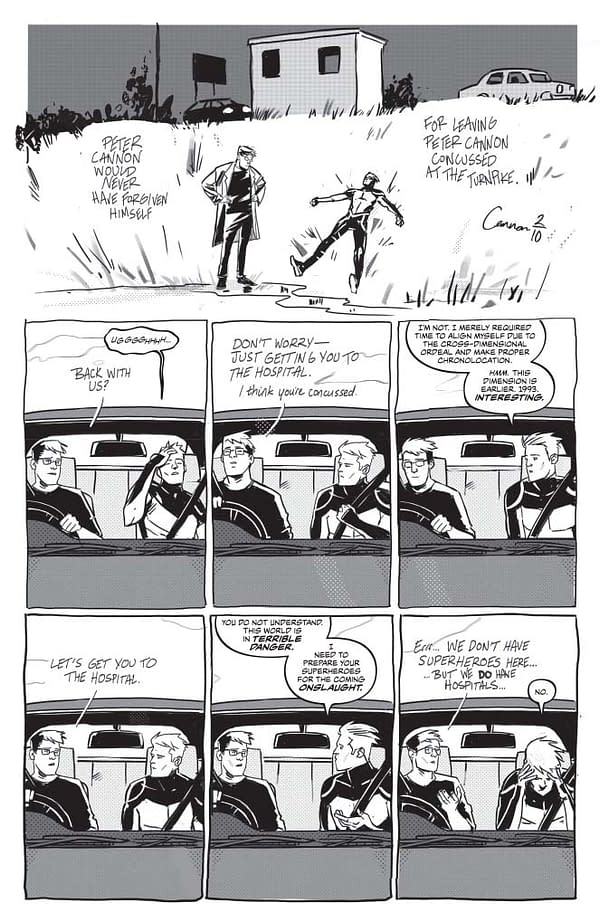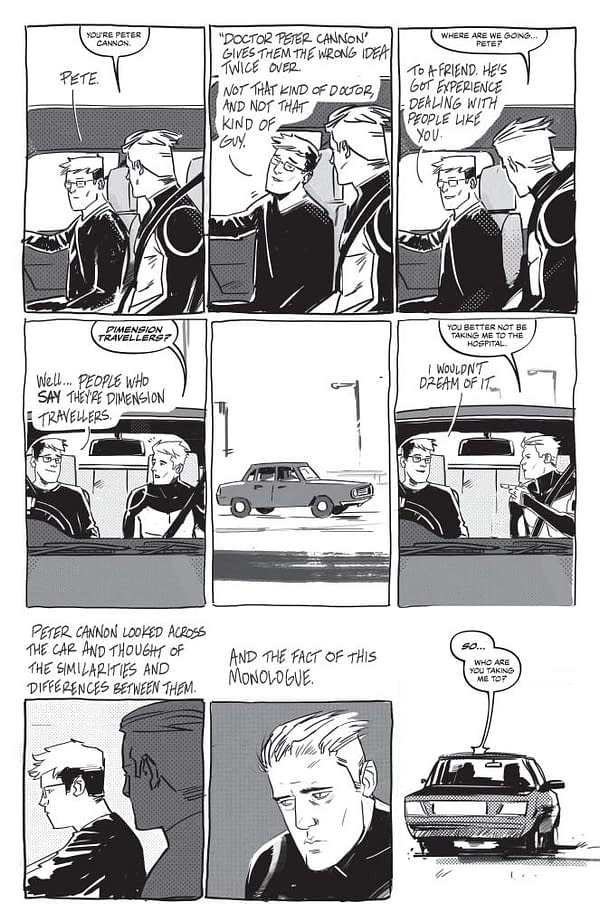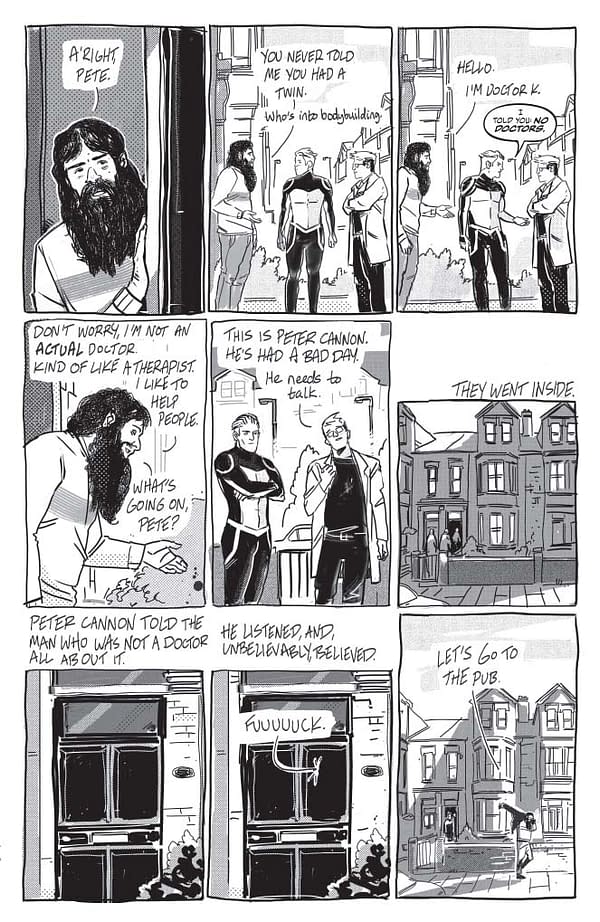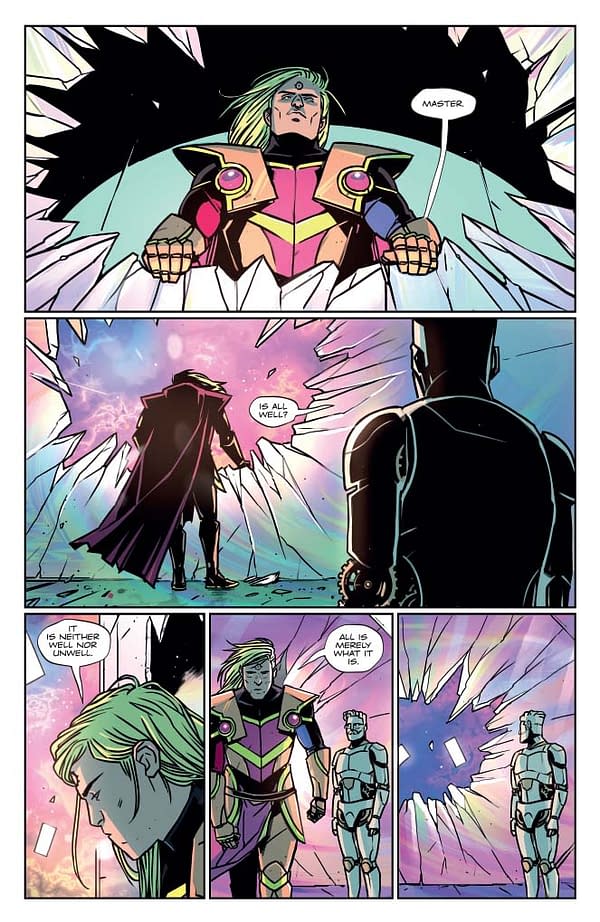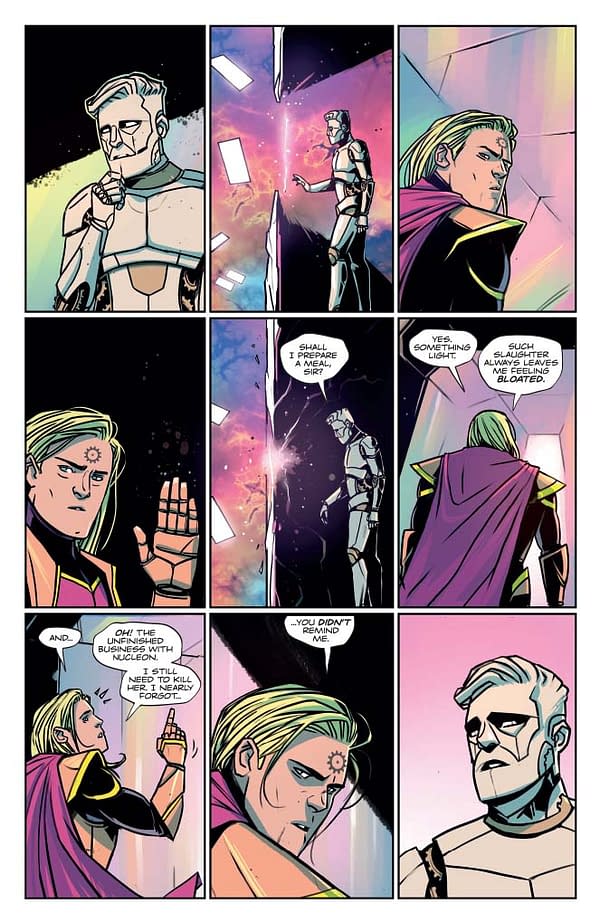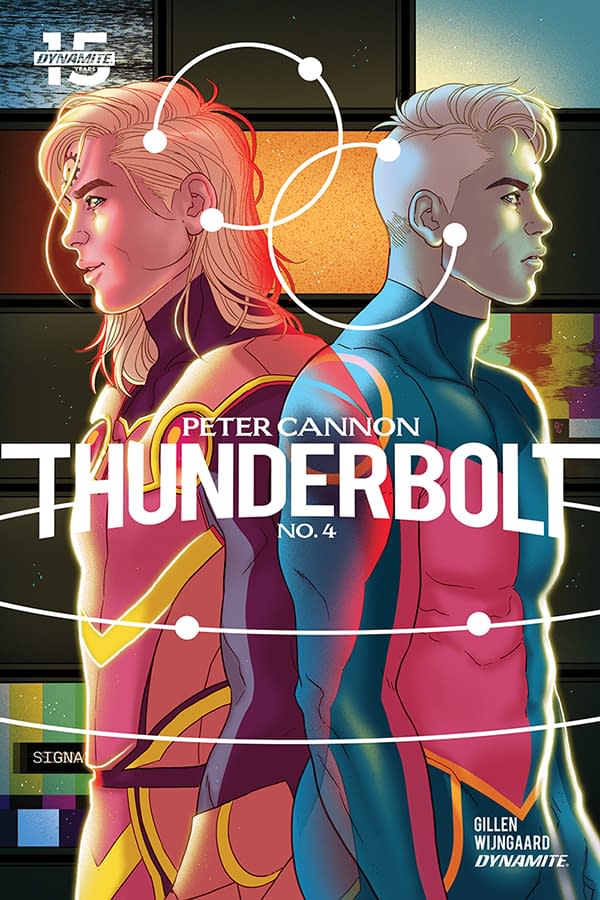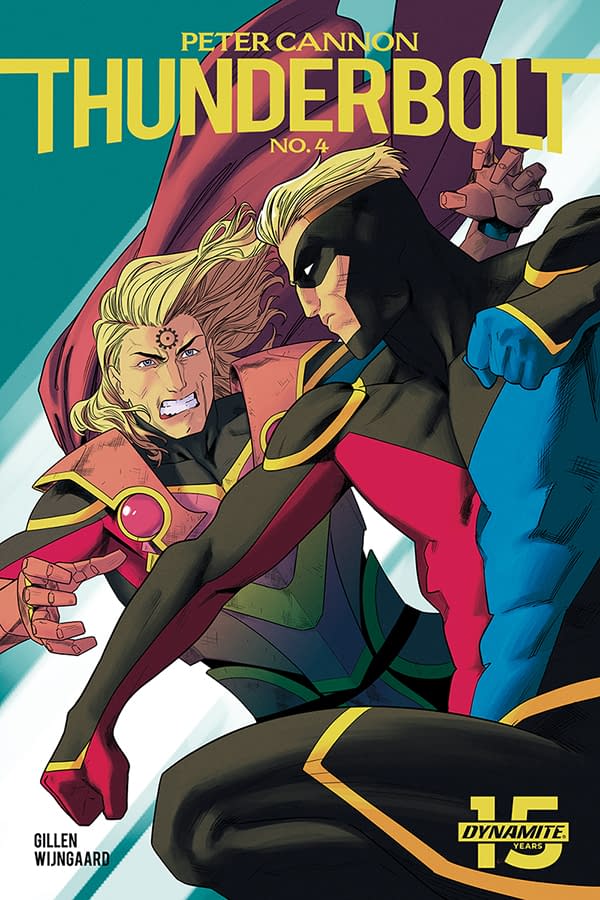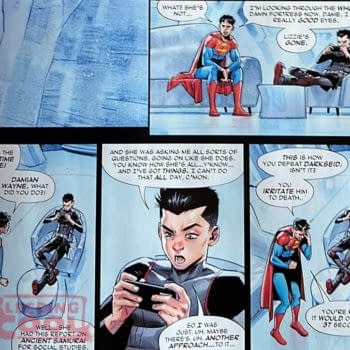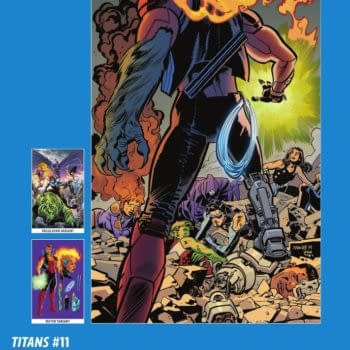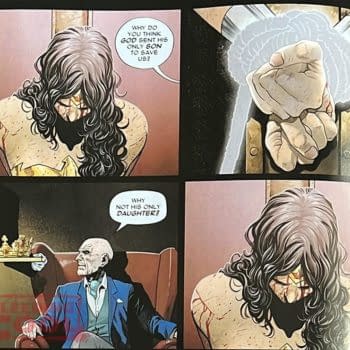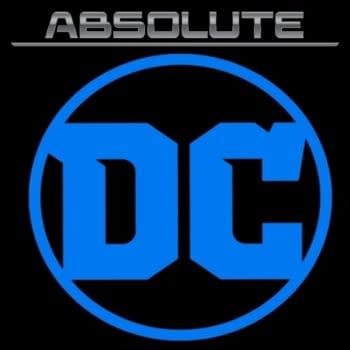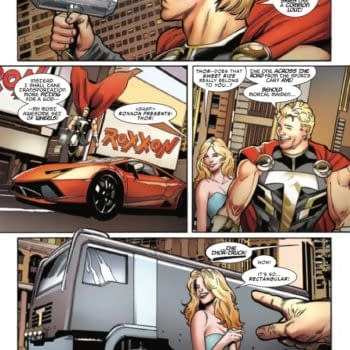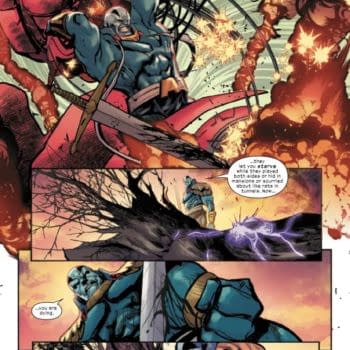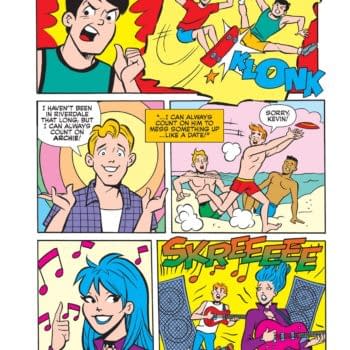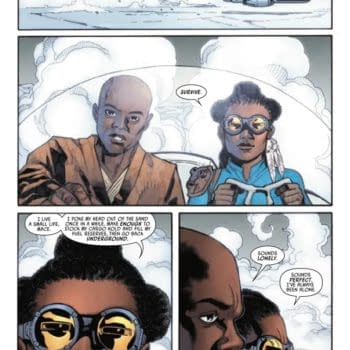Posted in: Comics | Tagged:
Kieron Gillen's Writer's Commentary on Peter Cannon: Thunderbolt #4 – "Let's Drop a Superheroic Character Into a Mundane Universe"
Kieron Gillen is tired. He writes his Writer's Commentary on Peter Cannon: Thunderbolt #4, on sale now from Dynamite, through sluggish fingers. Pity him…
Yes, I'm writing these tired again, so expect who knows what manner of randomness will emerge. Apologies in advance. You may think I'm being unprofessional, but I'm not being paid for this. [Rich adds: I'll buy you a large glass of white wine in the pub, okay?]
Right!
Probably best to get the heavy lifting out of the way first – the previous issues have been exploring some of the lines that drew out from Watchmen. This issue steps sideways at Watchmen, to look at it from a different angle. Not wanting to just Explain The Comic, this issue is a little eyebrow raise at those who subsume Watchmen into the American comic book tradition without actually looking at the scene which Watchmen emerged from.
This is an issue which is primarily a homage to Eddie Campbell's Alec comics. It's mainly the King Canute Crowd, but there's a little of How To Be An Artist in there too. They're best available in the enormous and reasonably priced omnibus, The Years Have Pants, which I'd recommend you get. I came to comics late, but I was immediately attracted to the Alec books, which were one of the key influences on Phonogram which is rarely spotted (understandably, because it's almost invisible because we've buried it in genre). Alec is about telling these autobiographical stories of real people with a degree of romance and glamour – rather than the somewhat cold and deglamorizing approach that a lot of autobio books take. Alec is wonderful in how it freezes a real moment and understands the poetry of it.
It's also classic of the 1980s British comic scene. Like Watchmen.
And it uses and explores the nine-panel grid. Like Watchmen.
Alan Moore's also in it.
Of course, while this is, in its field, famous work, it's not exactly something that the core superhero comic fan will have necessarily read. In which case, you wonder what's the point of a loving riff like this. Primarily, because it works as its own thing. A homage is a thing in and of itself and has its own energies. In a real way, all someone needs to know with this issue is "Hmm. This looks like an Indie comic." The conventions we're using just say everything you need to know, and the rest is gravy.
I hope so, anyway. If you're at all entertained by this issue, I can't recommend the Alec books enough. Go buy. You'll love 'em.
Page 1
Firstly, it has to be said everyone has outdone themselves here. Caspar mutating his style to work like this, resisting the flourishes of genre. Mary just being cool with her not having any work to do for an issue. And Hassan who… well, this is not the sort of job that gets a Best Letterer Eisner, but it absolutely should.
Worth stressing – the in-universe text is all hand lettered. Having Cannon's lettering remain in the superhero universe is our immediate "we are playing games with what reality is" here.
The opening panel is a direct homage to the famous first panel of The King Canute Crowd, and its immortal line: "Danny Grey never really forgave himself for leaving Alec MacGarry asleep at the turnpike." Don't worry, this is the most homage-y bit, and I'm not going to say them all.
A steady angle is a key Alec technique – this is much more the approach in this book. I took about The King Canute Crowd and wanted to try and use some of the style to tell this story.
Page 2
We set up the riff here – "Let's drop a superheroic character into a mundane universe" in the first page, but the second shows what we're doing "And have our analogues have mundane analogues here."
I originally wrote this scene as three pages but hit my page count, so had to compress it down to two pages. In the process, I actually miscount, and only have eight panels on the page. So Caspar jumps in and adds the still moment of time. It also creates a fun long pause before Cannon has a go at Pete.
Notice how we move to bleed much more. Notice how captions are done, warping the panel top allow it.
Page 3
I want to give credit here. I was chatting about this episode with some friends before I'd even written issue 1, and the idea of having mundane Watchmen analogues. Ray Fawkes chips in "And Rorschachs becomes a Therapist!" Which is such a good idea, I started riffing the scene you'll reach later, and then I swear, as it's clearly the right idea. I would normally bin an idea a friend had, but in this case, it clearly served my intent. Ray gave me the okay. Love Ray. Ray is a hero.
I'm a Midlander, and I don't think I've ever written "A'right" before in a comic. The Americans have ruined me.
I'll say this – one of the fun things about doing hand lettering like this is that you get to do stuff like panel 2, and it feels much more natural. I'd make Hassan do them all, but Hassan would kill me.
In a quiet way, this is one of my favourite pages in this entire issue. That panel at the end of Doctor K stomping off to the pub is a delight.
Page 4-5-6-7-8
I've somehow got it in my head that there are only four pages in this issue when there's clearly 5.
It does break the aesthetic purity of the issue a little, I suspect, but these pages make the promise that we will be returning to this kind of look. The juxtaposition between the two pages is going to be interesting too. I can't wait to see it in print – the last page is on the same spread as the start of the second page, and it's going to be really strange. The strangeness of this is a delight.
Necessary for two reasons – partially showing some more RoboTabu and Thunderbolt interaction, setting the attack in motion and (most importantly) closing the time loop with last issue and the death of Nucleon. If you juxtapose the two attack panels with the ones in issue 3, it basically forms a single image. There's a wonderful section in Watchmen when Manhattan becomes unstuck in time and walks across two panels on two separate pages, his position in both. This is kind of weaponizing that kind of time-doesn't-exist play.
Amazing colouring from Mary on the punch with the greens.
I'm pretty sure that Thunderbolt is going to fix that broken screen between issues.
The juxtaposition of writing styles is a lot of fun for me, as well as the art style. This genre-appropriate slightly stilted delivery of Thunderbolt compared to the Alec-Homage Sections. These two things should not be together.
Page 9-10
Another close to 1:1 homage from the eponymous King Canute. Clearly, we changed the name, though that it actually had a phonebox near it in the King Canute was a bit of a spooky coincidence when we needed one.
We meet our other analogues – I wish I had more room to live with them, but we get a little pen portrait. The most important is Eddie the Comic. You can imagine the moment I realized that the Comedian shared a name with Campbell was a hell of a time for me.
Hrrm is Watchmen's funniest joke, clearly.
I just want to write how Caspar approaches these pages – look at those beer pumps, right? It's great to see him just play on these pages, how he uses the tones. Give him all the money immediately.
11-12
This was the riff which I immediately came out with when Ray said "and Rorschach as a Therapist."
Rorschach's archetypal element isn't his objectivist. That's how he expresses the archetype. Rorschach's key thing is he is a true believer in a belief structure. You change the belief structure, you can get someone just as driven in a different way.
The middle panel on page 14, of the character delivering the line, is another interesting element of Alec. We keep this naturalism throughout, these very undramatic shots, and then you do something which freezes a moment. I love this.
Page 13
Now, that's the other thing about Alec which the page does a little of – just the fluidity of how the story is told. There are the tricks like using the captions as a shorthand, but then the hard cuts to a caption to fill a gap, and find a different moment, and then to highlight a line.
Page 14
This is the stuff which is riffing on How To Be An Artist most. That's the Alec Volume which is mostly a story about the rise and fall of the British Indie Comic Scene across the 1980s, and a very different perspective on the Graphic Novel boom than we tend to think of. If I was really going for just a homage, I'd do it all in second person like the original, but that felt like a distracting stylistic choice in something like this.
I did keep the Tundra joke, though.
This sets the story in a place – just after the close of Tundra, when things were particularly bleak in comics. The revolution had failed. The end of comics' sixties, if you will. Of course, we're also nearly thirty years from there. Perspective matters.
"I liked them, Eddie" Me too, Doctor K, me too.
I loved doing this issue. It's just a very way than I normally get to write comics, and I do think of the completely different direction my career could have gone. I'm too much of a pulpist to not have done genre work at all, but still.
This was fun.
Page 15
I have no idea how the "when they're talking they're covering the alien invasion" bit works, but I had fun with it.
Page 16
When Caspar sent over this page, it was the one when I was a little bit stunned. You know an idea is an interesting idea, and you think you can get some interesting effects from dropping an alien invasion and doing it in the conventions of a different genre. I knew it would be weird, but seeing an alien ship over this kind of landscape is absolutely destabilising for me. This is wrong.
I think I rewrote the captions for this after seeing the page to capture some of that feeling.
Still, even at a moment like this, throwing in a joke felt right. You move tone around.
Page 17
See! That very useful phonebooth. This is, of course, an era when none of these characters would have had a mobile phone. Perhaps never even seen a mobile phone.
Really like what Caspar does with the panelling here, in the three tier structure. Finding space for the moment. The little Ring! Ring! Was that Caspar or Hassan? I honestly can't remember, and I also can't tell, which is absolutely part of the joy of this.
Page 18-19-20
In the same way, I didn't know how Cannon was going to travel in issue 2, I had no idea how Cannon would travel back in this. I just knew I'd work out something that felt right. I'd written most the issue before even having the idea. Sometimes your inspiration definitely makes you wait.
(Then I went back and retrofitted the script to make sure there was a polaroid there, of course, and set up the other bits of connective tissue.)
Yes, the real ancient scrolls are the friends we've met along the way.
I haven't said how much I love the choice to give Pete glasses. Just a very small thing which grounds him as a flawed human being rather than this superheroic creature. Plus, lets us tell them apart easily.
Hassan did the lettering of the writing beneath the image. I love the doctor's finger gun. Yes, this is in its own way a nine-panel grid structure – there's a wonderful bit in King Canute where a trip to France is told in polaroids.
I wrote a lot in terms of off-panel chat but ended up cutting it all to just the single line, which makes me smile.
Thanks, Eddie, indeed.
Anyway, that's this issue. Next! The grand finale, where we see if we can actually find an ending for this rollercoaster.
Hope you're enjoying it as much as we are.


